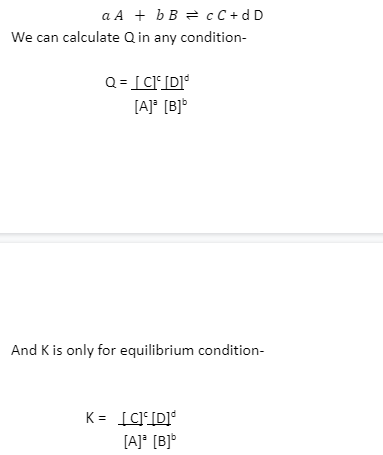Equilibrium v/s non – equilibrium condition
When the chemical reaction is in a balanced state i.e forward reaction and reverse reaction happens at equal rate, it states that reactant and product concentration remains same, is called equilibrium. Whereas in non-equilibrium, there is an imbalance of state i.e. forward and reverse reactions are not equal.
When the external force which is acted on the surface is balanced, then it is said to be in equilibrium condition. In non-equilibrium conditions, there is a swap of energy and momentum in the liquid. Creation of new products and reactants is done by readjustment of reaction to go back to equilibrium.
Reaction quotient:-
The reaction quotient (Q) is a function of the proportion of quantities of reactants and products at a specific moment in time during a chemical reaction. We can tell whether the forward or backward reaction will be preferred by making a comparison of Q to the reaction’s equilibrium constant, Keq.
In a reaction, there are always two amounts present: one is reactant and another one is product, so the measurement of product and reactant amount in a reaction is called Reactant Quotient. In other words, we can say that a reaction quotient is a ratio of product of inceptive concentration of products to the product of inceptive concentration of reactants beneath non – equilibrium conditions.

Calculating reaction quotient:-
- By expression people assume that reaction quotient is used to calculate equilibrium condition or constant but it can calculate any condition.
- When a reaction moves towards equilibrium direction it can be determined by reaction quotient.
- If K > Q , then reaction will be in forward direction and if K < Q then reaction will be in reverse direction and if K= Q then reaction will be in equilibrium.
For calculating Q :-
- First write the expression of the reaction to the reaction quotient.
- Then find the molar concentration of reactant and product.
- Then put the values and solve the equation.
K versus Q:-
The most important difference between Q and K is that, K defines a reaction which is in equilibrium and Q defines a reaction which is not in equilibrium.

Comparing Q versus K:-
- If Q< K, then reaction move towards products
Q< K,. Q ∝ product
reactant
If Q is smaller than K, that means the reaction has “many reactants” or less product.
- If Q>K, then the reaction moves towards the reactant.
Q>K,. Q ∝ Reactant
Product
If Q is bigger than K, that means the reaction has “many products” .
- And if Q=K, the reaction is always in equilibrium.
The reaction quotient has the same shape as the equilibrium constant and is a function of the reactant and product concentrations and/or activity. The distinction is that Q only applies while the reaction is not in equilibrium, hence its value can change. The reaction quotient, like the equilibrium constant, can be a consequence of activities or concentrations.
CONCLUSION
The reaction quotient is the ratio of inceptive concentration of products to inceptive concentration of reactants. In this we calculate the molar concentration of reactant and product and it is similar to equilibrium constant but the only difference is that equilibrium constant works in equilibrium and reaction quotient works in non- equilibrium condition. It can be used in any condition at any time. Reaction quotient is denoted as Q and equilibrium constant is denoted as K. If Q < K then reaction moves towards product and if Q > K then reaction moves towards reactant direction. And if Q=K , then it doesn’t move it in equilibrium condition.
To estimate how a reaction will go to attain equilibrium, we can compare the reaction fraction Q to the equilibrium constant K. In addition, since we are frequently curious about various thermophysical properties even if we’re not at equilibrium, Q may appear in other chemistry subjects and equations.
 Profile
Profile Settings
Settings Refer your friends
Refer your friends Sign out
Sign out





